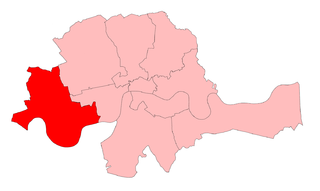Related Research Articles

Eton and Slough was a parliamentary constituency represented in the House of Commons of the Parliament of the United Kingdom. It elected one Member of Parliament (MP) by the first-past-the-post voting system.
South Buckinghamshire was a parliamentary constituency in the county of Buckinghamshire, England. From 1950 to 1974, it returned one Member of Parliament (MP) to the House of Commons of the Parliament of the United Kingdom, elected by the first-past-the-post voting system.

Chelsea was a borough constituency, represented in the House of Commons of the Parliament of the United Kingdom.
Birmingham Aston was a constituency of the House of Commons of the Parliament of the United Kingdom. From 1918 to 1974 it elected one Member of Parliament (MP) by the first-past-the-post system of election.
Birmingham Central is a former parliamentary constituency in the city of Birmingham, England. It returned one Member of Parliament (MP) to the House of Commons of the Parliament of the United Kingdom, elected by the first-past-the-post voting system.
Birmingham East was a parliamentary constituency in the city of Birmingham, England. It returned one Member of Parliament (MP) to the House of Commons of the Parliament of the United Kingdom, elected by the first-past-the-post voting system.
Birmingham North was a parliamentary constituency in the city of Birmingham, England. It returned one Member of Parliament (MP) to the House of Commons of the Parliament of the United Kingdom, elected by the first-past-the-post voting system.

Barnet was a parliamentary constituency in what is now the London Borough of Barnet, which returned one Member of Parliament (MP) to the House of Commons of the Parliament of the United Kingdom.

Balham and Tooting was a constituency in South London, which returned one Member of Parliament (MP) to the House of Commons of the Parliament of the United Kingdom. It was created for the 1918 general election and abolished for the 1950 general election.
Birmingham South was a parliamentary constituency in Birmingham which returned one Member of Parliament (MP) to the House of Commons of the Parliament of the United Kingdom from 1885 until it was abolished for the 1918 general election.
Birmingham West was a parliamentary constituency represented in the House of Commons of the Parliament of the United Kingdom. It returned one Member of Parliament (MP), elected by the first-past-the-post voting system.
Birmingham Small Heath was a parliamentary constituency centred on the Small Heath area of Birmingham. It returned one Member of Parliament (MP) to the House of Commons of the Parliament of the United Kingdom.
Wandsworth Central was a parliamentary constituency in the Wandsworth district of South London. It returned one Member of Parliament (MP) to the House of Commons of the Parliament of the United Kingdom, elected by the first-past-the-post voting system.
Birmingham Bordesley was a borough constituency in the city of Birmingham, which returned one Member of Parliament (MP) to the House of Commons of the Parliament of the United Kingdom. Elections were held using the first-past-the-post voting system.
Birmingham Moseley was a constituency of the House of Commons of the Parliament of the United Kingdom from 1918 to 1950. It elected one Member of Parliament (MP) by the first-past-the-post system of election.
Birmingham All Saints was a parliamentary constituency in the city of Birmingham, which returned one Member of Parliament (MP) to the House of Commons of the Parliament of the United Kingdom. Elections were held using the first-past-the-post voting system.
Bournemouth East and Christchurch was a former United Kingdom Parliamentary constituency. It returned one Member of Parliament, using the first past the post electoral system from the 1950 United Kingdom general election until the constituency was abolished in 1974.
Brierley Hill parliamentary constituency was located in the West Midlands of England. It returned one Member of Parliament (MP) to the House of Commons of the Parliament of the United Kingdom, elected by the first past the post system.
Bucklow was, from 1945 to 1950, a county constituency of the House of Commons of the Parliament of the United Kingdom. It elected one Member of Parliament (MP), elected by the first past the post voting system.
Bromley is a former constituency for the House of Commons of the Parliament of the United Kingdom. The most famous MP was Harold Macmillan, Prime Minister, 1957 to 1963.
References
- ↑ "The House of Commons (Redistribution of Seats) Order 1945. SI 1945/701". Statutory Rules and Orders 1945. Vol. I. London: His Majesty's Stationery Office. 1946. pp. 682–698.
- Boundaries of Parliamentary Constituencies 1885-1972, compiled and edited by F.W.S. Craig (Parliamentary Reference Publications 1972)
- British Parliamentary Election Results 1918-1949, compiled and edited by F.W.S. Craig (Revised edition - Macmillan Press 1977)
- Who's Who of British Members of Parliament, Volume IV 1945-1979, edited by M. Stenton and S. Lees (Harvester Press 1981)
- Leigh Rayment's Historical List of MPs – Constituencies beginning with "A" (part 1)